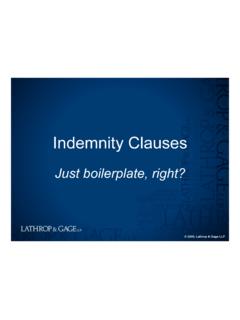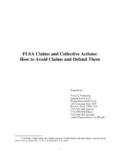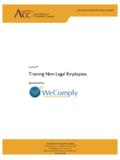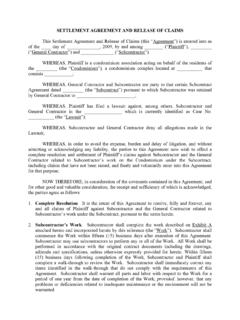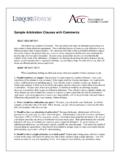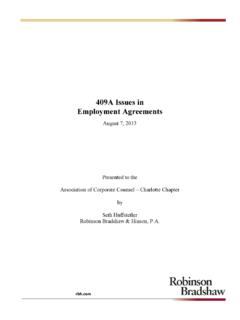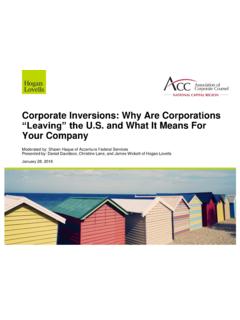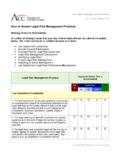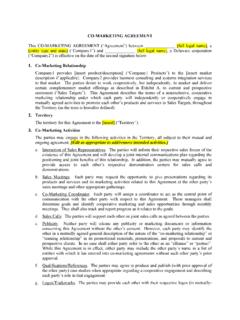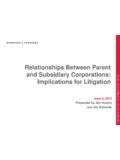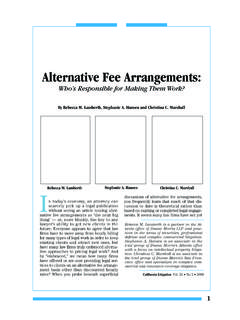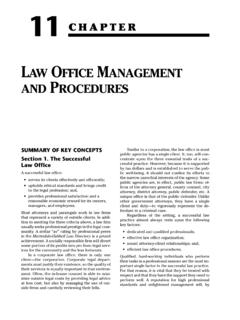Transcription of 104:When to Set a Reserve-Now, Never, or …
1 ACC'S 2004 ANNUAL M EETING THE NEW FACE OF IN-HOUSE COUNSEL. 104:When to Set a reserve -Now, never , or Somewhere in Between Christopher M. Holmes Partner and National Director of SEC Matters Ernst & Young LLP. Bill Phelan Assistant Controller Sears, Roebuck and Co. Patrick R. Thesing Senior Vice President, Associate General Counsel and Chief Litigation Counsel Stewart Title Guaranty Company This material is protected by copyright. Copyright 2004 various authors and the Association of Corporate Counsel (ACC). Materials may not be reproduced without the consent of ACC. Reprint permission requests should be directed to James Merklinger at ACC: 202/293-4103, ext. 326; ACC's 2004 ANNUAL MEETING THE NEW FACE OF IN-HOUSE COUNSEL. Faculty Biographies Christopher M. Holmes Christopher M.
2 Holmes serves as Ernst & Young's national director of SEC matters. He is partner in the national professional practice for E&Y's Assurance and Advisory Business Services (AABS) and is been based in Washington, DC. Mr. Holmes has extensive experience with corporate financial reporting and SEC filing requirements. He represents Ernst & Young on the SEC regulations committee of the AICPA. He also has represented Ernst & Young on the AICPA's Task Force on Acquired In-Process Research & Development and the AICPA's Task Force on Valuing Private Company Equity Securities. Mr. Holmes recently concluded his role as the coordinating partner for a global information technology company, and he currently serves as the concurring partner on a large wireless communications company. He rejoined the firm in 1994 after a two-year fellowship in the Office of the Chief Accountant at the Securities and Exchange Commission.
3 As a professional accounting fellow, Mr. Holmes was responsible for consulting with registrants on accounting and reporting matters, principally business combinations, the impairment of intangible assets, and non-monetary transactions. He began his career in the firm's audit practice in Winston-Salem, North Carolina where he served large public manufacturing companies. Mr. Holmes is a member of the AICPA and the North Carolina Association of Certified Public Accountants. He is licensed to practice in North Carolina, Pennsylvania, and the District of Columbia. Mr. Holmes received a BS from the University of North Carolina at Chapel Hill. Bill Phelan Assistant Controller Sears, Roebuck and Co. Patrick R. Thesing Senior Vice President, Associate General Counsel and Chief Litigation Counsel Stewart Title Guaranty Company This material is protected by copyright.
4 Copyright 2004 various authors and the Association of Corporate Counsel (ACC). 2. ACC's 2004 ANNUAL MEETING THE NEW FACE OF IN-HOUSE COUNSEL. NOW, never OR. I N B E T W E E N ? : SOMEWHERE. The Nuts and Bolts of Setting Reserves Y. our company has received word from the head of one of your business divisions that a former customer is alleging your com- pany supplied millions of dollars of defective product and the for- mer customer now wants its money back. Although you have been assured that the product met all industry standards and was manufactured properly, you, as in-house counsel, are now faced with a myriad of questions. Does the suit have merit? Is settlement a viable option, or should the case be vigor- ously defended? Apart from those purely legal considerations, you also must help determine whether the com- pany is required to recognize the potential loss contingency in the financial statements and dis- close the existence of the potential suit to shareholders.
5 How you go about making that decision is often a convoluted task, and one that must be undertaken in coordination with the accounting and financial department of your company. If you reach the wrong decision, your company could be required to restate its financial statements, and perhaps face shareholder litigation, SEC. enforcement action, or criminal charges. Before you start digging out your resume, though, take heart. The good news is that there are standards governing what to do in the case of loss contingencies; the bad news is that the stan- dards are less than straightforward. This article will help you gain a firm understanding of the basics of the pertinent rules, and will enhance your understanding by applying those principles to several hypotheticals. By examining the most difficult accounting and financial scenarios, we will provide you practical solutions to those issues, so you will know when and how to set a reserve .
6 B Y P E T E R J . B R E N N A N , C H R I S H O L M E S , A N D. B I L L P H E L A N. ACC Docket July/August 2004. This material is protected by copyright. Copyright 2004 various authors and the Association of Corporate Counsel (ACC). 3. ACC's 2004 ANNUAL MEETING THE NEW FACE OF IN-HOUSE COUNSEL. This article is drawn from one of ACC's most popular webcasts, When to Set Reserves, originally offered in June 2003, and moderated by Kathie S. Lee, Litigation Committee Vice Chair. The authors gratefully acknowledge the assistance of Mary Murphy in transforming the webcast into an article, and for the additional research she provided. standards established by the Financial Accounting Standards Board (FASB) that require the exercise of Peter J. Brennan is a partner in the litigation judgment in applying the standards' basic principles.
7 Department at Jenner & Block in Chicago. He is In particular, FAS 5, which establishes standards for the Immediate Past Chair of ACC's Litigation Committee and a former Associate General financial accounting and reporting for loss contin- Counsel Litigation at Sears, Roebuck and Co. gencies, dictates in paragraph eight that a loss con- He can be reached at tingency must be recognized as a charge to income if both of the following standards are met: a. Information available prior to issuance of the Chris Holmes is Ernst & Young's National Director financial statement indicates that it is probable of SEC Matters. Chris is based in Washington, that an asset had been impaired or a liability had and represents Ernst & Young on the SEC been incurred at the date of the financial state- Regulations Committee of the American Institute of Certified Public Accountants.
8 He can be ments. It is implicit in this condition that it must reached at be probable that one or more future events will occur confirming the fact of the loss; and b. The amount of loss can be reasonably estimated. 4. (Emphasis added.). Bill Phelan is a Certified Public Accountant with twenty years of experience obtained practicing FAS 5 was one of the initial standards adopted in both the Corporate Reporting and Public (in March 1975) by the FASB. While the passage of Accounting disciplines. Currently, as the Assistant Controller for Sears, Roebuck and Co., time has seen the adoption of over 140 additional Bill oversees all accounting activities for standards, there has been little modification to the Sears businesses. He can be reached at basic principle of this particular rule that a loss contingency must be recognized as an expense if the loss is probable and the amount can be estimated.
9 The first of those two conditions the probability of the loss is often difficult to assess because the threshold for recognition is not established in terms LOSS CONTINGENCIES: WHAT EXACTLY ARE THEY? of numerical probability. FAS 5 recognizes a range of probabilities that A loss contingency is a loss ( , the impairment such a future event will occur and uses the terms of an asset or the incurrence of a liability) arising probable, reasonably possible, and remote to iden- from a past event, the amount of which, if any, will tify the three areas within that range: be confirmed by a future event that is not within the Probable: The future event or events are likely company's Examples of loss contingencies to occur;. include, but are not limited to, the threat of or pend- Reasonably possible: The chance of the future ing lawsuits against the corporation, or its officers if event or events occurring is more than remote, they have been indemnified by the Such a but less than likely; or contingency can, in certain cases, obligate the corpo- Remote: The chance of the future event or events ration to record a reserve in anticipation of a judg- occurring is slight.
10 Ment against the corporation or a settlement, or This classification is significant, as it determines perhaps disclose the existence of the contingency in the company's obligation to make an accrual and/or a its financial statements. In such circumstances, it is disclosure, as discussed below (see also What the essential that members of the in-house counsel and Future Holds .. and How to Account for It, p. 34). accounting staff work together to assess the corpora- tion's obligations and evaluate what if any disclosure Accrual yes, disclosure..perhaps? Accrual no, must be made, and the amount, if any, of the loss disclosure .. maybe? contingency that must be The initial challenge for in-house counsel and The uncertainty surrounding the reporting and accounting is to accurately assess whether the disclosure obligations is due in large part to the accrual must be made at all.
